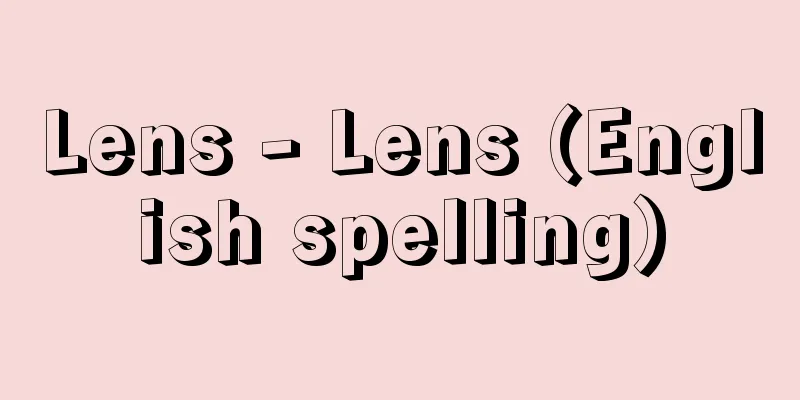Lens - Lens (English spelling)

|
A lens is a transparent material such as glass or plastic whose front and back surfaces are polished to a spherical shape (called a simple lens). Some lenses are aspherical instead of spherical, or have one flat surface. They have the property of converging or diverging light by utilizing the difference in refractive index with the surrounding medium. High-end optical instruments use compound lenses that combine two or more simple lenses. Both simple and compound lenses are sometimes simply called lenses. The following mainly describes the properties of simple lenses, but most of them also apply to compound lenses. The straight line connecting the centers of curvature of the front and back surfaces of a simple lens is called the optical axis of the simple lens, or simply the axis. The distance between the two intersections of the lens axis and the front and back surfaces is called the thickness of the lens. [Kazuo Miyake] Focus and focal lengthLight rays that are parallel to the axis of a lens intersect at a single point on the axis when they pass through the lens and are extended directly or inversely. This is called the image focus or back focus. A lens whose image focus is behind the lens is called a convex lens or positive lens, and one whose image focus is in front is called a concave lens or negative lens. Conversely, when light rays that enter a lens so as to diverge from or converge to that point travel parallel to the axis after passing through the lens, this point is called the object focus or front focus. A lens that is sufficiently thin is called a thin lens. A lens whose thickness cannot be ignored is called a thick lens. The distance from the center of a thin lens to its focal point is called the focal length. Points that are in an object-image relationship with respect to a lens are said to be conjugate to each other, and combinations of these points are called conjugate points. [Kazuo Miyake] Lens formula and magnificationLet s and s ' be the distances from the center of the thin lens to the object and image, and f ' be the distance to the image-side focal point. In this case, s , s ', and f ' are positive when measured to the right from the center of the lens.
[Kazuo Miyake] Paraxial rays and ideal imagingThe lens formula above is only valid strictly when the light rays used to create the image have a small inclination to the optical axis and the object and image are small. Light rays that fall under this restriction are called paraxial rays. In other words, the lens formula is valid only when an image is created using paraxial rays. This type of image formation is called ideal imaging. [Kazuo Miyake] Lens aberrationWhen the light rays used are no longer paraxial, deviations from ideal imaging, or aberrations, appear. The most well-known of these is spherical aberration. This aberration occurs when light rays from an object point on the axis, which are at various angles to the axis, do not converge completely to a single point on the axis after passing through the lens. In other words, the image of a single point does not become a point, resulting in what is known as blur. There is also coma aberration, in which the image of an object point slightly off-axis does not become a point, resulting in a distribution of light (blur) like that of a comet. There is also astigmatism, in which the light converges not at one point but at two points separated by a distance, for object points further away from the axis, and curvature aberration (curvature of the image plane), in which the image of a flat, planar object becomes a curved surface. There is also distortion, which becomes more pronounced as you move towards the edge of the image plane. This is when the image is not exactly proportional to the object, resulting in distortion. These five aberrations are known as Seidel's five aberrations, named after the researchers who studied them. In addition, there is chromatic aberration, in which the position and magnification of an image change depending on the wavelength of light, because the refractive index of the glass used varies depending on the wavelength of light. It is impossible to eliminate chromatic aberration with a single lens, so a compound lens is used. For example, to eliminate chromatic aberration (achromatize) for two wavelengths of light, two types of glass with different rates of change in refractive index with respect to wavelength (dispersion) are combined as positive and negative lenses. This is called an achromat. A lens that is achromatized for three or more wavelengths of light is called an apochromat. It is impossible to completely correct all five Seidel aberrations, and in practice aberration correction is performed to the extent necessary depending on the intended use of the lens. Aberration correction is an important task when designing a lens, and recently automatic lens design has been carried out using electronic computers. [Kazuo Miyake] Lens VarietiesSingle lenses are used as eyeglass lenses. People with farsightedness or presbyopia use convex lenses, while people with myopia use concave lenses. Astigmatism is caused by astigmatism in the naked eye, so to correct this, cylindrical lenses or lenses with different focal lengths in two perpendicular directions are used. Recently, plastic lenses have come to be worn tightly on the eyeball and used as eyeglasses (contact lenses). Single lenses are also used as magnifying glasses. Compound lenses include the objective lenses and eyepieces of telescopes and microscopes. The objective lens of a telescope is made of two lenses placed close together to make it an achromat. Large lenses such as those used in astronomical telescopes are expensive, so reflectors are used instead of lenses. The objective lens of a microscope is small, but those for high magnification have a complex structure. The eyepieces of telescopes and microscopes are almost the same, consisting of two single lenses placed apart to make an achromatic lens. A photographic lens is made up of several lenses, sometimes more than 10, in order to balance and correct all aberrations to a degree that does not interfere with the intended purpose. Recently, lenses called zoom lenses have come into use, in which moving a part of the lens changes the size of the image but not its position. [Kazuo Miyake] Lens performanceThe quantities used to indicate lens performance include focal length, brightness, and resolution. Sometimes, instead of focal length, the quantity called refractive power, which is its reciprocal, is used. The unit of refractive power is the reciprocal of the focal length expressed in meters, and is called a diopter. It is used to indicate the refractive power of eyeglass lenses. To express brightness, for telescope objective lenses, a numerical value representing the lens diameter is sometimes used, but as with photographic lenses, the F- number, which is the ratio of the focal length to the effective diameter of the lens, is used. The smaller the F -number, the brighter the image. For microscope objective lenses, if the angle between the optical axis of the light ray that leaves the axial object point and enters the edge of the objective lens is θ, and the refractive index of the medium in front of the lens is n , then the quantity n sinθ is used, which is called the numerical aperture. A lens does not just have to have a high magnification, but must also have a resolution that matches the magnification. Resolution, which indicates how fine a lens can resolve, is related to the F -number and numerical aperture. [Kazuo Miyake] "Lens Design Engineering" by Nakagawa Jihei (1986, Tokai University Press)" ▽ "The Fundamentals and Development of Photographic Lenses" by Ogura Toshinuno (1995, Asahi Sonorama)" ▽ "Illustrated Guide to Understanding Lenses" by Nagata Shinichi (2002, Nihon Jitsugyo Publishing)" ▽ "Illustrated Introduction to the Basics and Mechanisms of the Latest Lenses - Learning from Familiar Phenomena and Devices" by Kuwashima Mikio (2005, Hidewa System) [Reference] | | | |©Shogakukan "> Lens magnification (Diagram) Source: Shogakukan Encyclopedia Nipponica About Encyclopedia Nipponica Information | Legend |
|
ガラス、プラスチックのような透明体の前後の面を球面に磨いたもの(これを単レンズという)で、球面のかわりに非球面または一方の面を平面にしたものもある。周りの媒質との屈折率の差を利用して光を収束したり発散させたりする性質がある。高級な光学器械では、単レンズを2枚以上組み合わせた複合レンズが用いられる。単レンズ、複合レンズの両者を総称して単にレンズとよぶこともある。以下においては主として単レンズの性質について述べるが、その大部分は複合レンズにも成り立つ。単レンズの前後の面の曲率中心を結ぶ直線のことを、単レンズの光軸または単に軸という。レンズの軸と前後の面との二つの交点の間隔を、レンズの厚さという。 [三宅和夫] 焦点と焦点距離レンズの軸に平行に入射した光線は、レンズを通過したのち直接にまたは逆に延長したとき、軸上の1点で交わる。これを像側焦点(ぞうそくしょうてん)または後側焦点(こうそくしょうてん)という。像側焦点がレンズの後方にあるものを凸レンズ(とつれんず)または正のレンズ、前方にあるものを凹レンズ(おうれんず)または負のレンズという。反対にその点から発散またはその点に収束するようにレンズに入射した光線が、レンズを通過したのち軸に平行に進むとき、この点を物側焦点または前側焦点という。レンズの厚さが十分に薄いレンズのことを薄いレンズまたは薄肉レンズという。厚さが無視できないレンズのことを厚いレンズまたは厚肉レンズという。 薄いレンズの中心から焦点までの距離を焦点距離という。 レンズに関して物体と像の関係にある点は互いに共役であるといい、それらの点の組合せを共役点という。 [三宅和夫] レンズの公式と倍率薄いレンズの中心から、物体および像までの距離をs、s'、像側焦点までの距離をf'とする。このときs、s'、f'はレンズの中心から右方向に測ったときを正とする。
[三宅和夫] 近軸光線と理想結像前出のレンズの公式が厳密に成立するのは、像をつくるのに使われる光線が光軸と小さな傾きをしていて、物体および像が小さい場合に限られる。このような制限下にある光線のことを近軸光線という。すなわちレンズの公式は、近軸光線を使用して像が生ずる場合にのみ成立する。このような像の生じ方を理想結像という。 [三宅和夫] レンズの収差使用される光線が近軸光線でなくなると、理想結像からのずれ、すなわち収差が現れる。そのうちもっともよく知られているのが球面収差である。この収差は、軸上の物点から出て軸と種々の傾きをなす光線がレンズを通過後軸上の1点に完全に集まらないことによって生ずる。すなわち1点の像が点とならず、いわゆるボケを生ずる。このほか、軸からすこし外れた物点の像が点とならず、彗星(すいせい)のような光の分布(ボケ)を生ずるコマ収差がある。また、さらに軸から離れた物点に対して、光の収束する位置が1か所でなく前後に離れた2か所になる非点収差、および平らな平面状の物体の像が曲がった曲面となる湾曲収差(像面の曲がり)がある。さらに像面の縁のほうに行くにしたがって顕著となる歪曲(わいきょく)がある。これは像が物体に正確に比例せず歪(ゆが)みを生ずるものである。以上五つの収差は、これを研究した研究者の名を冠して、ザイデルの五収差といわれる。 このほかに、使用するガラスの屈折率が光の波長によって異なるため、像の生ずる位置および倍率が光の波長によって変化する色収差がある。色収差を取り除くことは1枚の単レンズでは不可能であり、複合レンズが用いられる。たとえば、二つの波長の光に対して色収差を除去する(色消しする)には、屈折率の波長に対する変化率(分散)の異なる2種類のガラスを正・負のレンズとして組み合わせる。これをアクロマートという。三つ以上の波長の光に対して色消しされたレンズのことをアポクロマートという。 ザイデルの五収差を全部完全に補正することは不可能であり、実際にはそのレンズの使用目的に応じて必要な程度にまで収差補正が行われる。レンズを設計するとき収差補正は重要な作業であり、最近は電子計算機を使用してレンズの自動設計が行われている。 [三宅和夫] レンズのいろいろ単レンズは眼鏡レンズとして用いられる。遠視および老眼の人は凸レンズ、近視の人は凹レンズを使用する。乱視は肉眼の非点収差によって生ずるので、これを補正するため円柱レンズ(シリンドリカルレンズ)、または直交する2方向の焦点距離が違っているレンズを用いる。最近はプラスチックでつくったレンズを眼球に密着して装着し、眼鏡として使用するようになった(コンタクトレンズ)。単レンズは虫めがねとしても用いられる。 複合レンズとしては、望遠鏡や顕微鏡の対物レンズおよび接眼レンズがある。望遠鏡の対物レンズは、2枚のレンズを接近してアクロマートにしたものが用いられる。天体望遠鏡のように大型のものは高価となるので、レンズのかわりに反射鏡が用いられる。顕微鏡の対物レンズは小型であるが、高倍率用のものは複雑な構成をしている。接眼レンズは望遠鏡のものも顕微鏡のものもほぼ同様で、2枚の単レンズを離しておいて色消しレンズになっている。 写真レンズは、すべての収差を使用目的に差し支えない程度にまで互いにバランスして補正されている。そのため数枚、場合によっては10枚を超えるレンズからなっている。最近はズームレンズとよばれるレンズの一部分を動かすと、像の大きさは変化するが像の位置は変わらないレンズが用いられるようになった。 [三宅和夫] レンズの性能レンズの性能を示す量としては、焦点距離、明るさ、解像力などが用いられる。焦点距離のかわりに、その逆数の屈折力という量が用いられることがある。屈折力の単位は、焦点距離をメートルで表した数値の逆数をとり、ジオプターとよぶ。掛け眼鏡レンズの屈折力を表すのに用いられる。 明るさを表すには、望遠鏡の対物レンズでは、レンズの直径を表す数値が用いられることもあるが、写真レンズと同様に、焦点距離とレンズの有効径との比Fナンバーが用いられる。Fナンバーが小さいほど明るくなる。顕微鏡対物レンズでは、軸上物点から出て対物レンズの縁に入射する光線が光軸となす角をθ、レンズの前方の媒質の屈折率をnとすると、nsinθなる量が用いられ、開口数とよばれる。 レンズはただ倍率が高ければよいというものでなく、倍率に見合った解像力を有しなければならない。レンズがどのくらい微細な点まで分解するかという能力を表す解像力は、Fナンバーや開口数に関係する。 [三宅和夫] 『中川治平著『レンズ設計工学』(1986・東海大学出版会)』▽『小倉敏布著『写真レンズの基礎と発展』(1995・朝日ソノラマ)』▽『永田信一著『図解 レンズがわかる本』(2002・日本実業出版社)』▽『桑嶋幹著『図解入門 よくわかる最新レンズの基本と仕組み――身近な現象と機器に学ぶ』(2005・秀和システム)』 [参照項目] | | | |©Shogakukan"> レンズの倍率〔図〕 出典 小学館 日本大百科全書(ニッポニカ)日本大百科全書(ニッポニカ)について 情報 | 凡例 |
>>: Lián shěng zì zhì (Lián shěng zì zhì)
Recommend
Mineralization - Mineralization
A phenomenon in which useful elements are concent...
Public loan
…In the narrowest sense, it is used synonymously ...
decoration
… [Patterns as decoration] The objects that are d...
Kakimoto Saru - The monkey under the persimmon
…Poet of the Man'yoshu. Although his birth an...
Fagopyrum cymosum (English spelling) Fagopyrum cymosum
…[Yoshiharu Iijima]. … *Some of the terminology t...
Goldenes Dachl (English spelling) GoldenesDachl
… Innsbruck, the state capital, faces the Inn Riv...
Raynaldus
…It also has a bell tower known as the Tower of P...
Aztec
A nation that flourished from the 14th century unt...
Sīdī Ifnī (English spelling)
…It became a Spanish colony in 1860, and was retu...
analog
...For example, quantities that have a minimum un...
Cygnus (the Swan)
Its abbreviation is Cyg. It is a major constellati...
Kiso [village] - Kiso
A village in Kiso County in the mid-west of Nagano...
Demon Sword Dance
A folk performing art handed down in the Kitakami ...
Hans Böckler
1875‐1951 German labour activist and politician. B...
King Lear
A five-act tragedy by the English playwright Shak...
![Indian Runner [species] - Indian Runner](/upload/images/67cf7a0811ff2.webp)






![Gohira [town] - Aira](/upload/images/67cacf6776d5c.webp)

